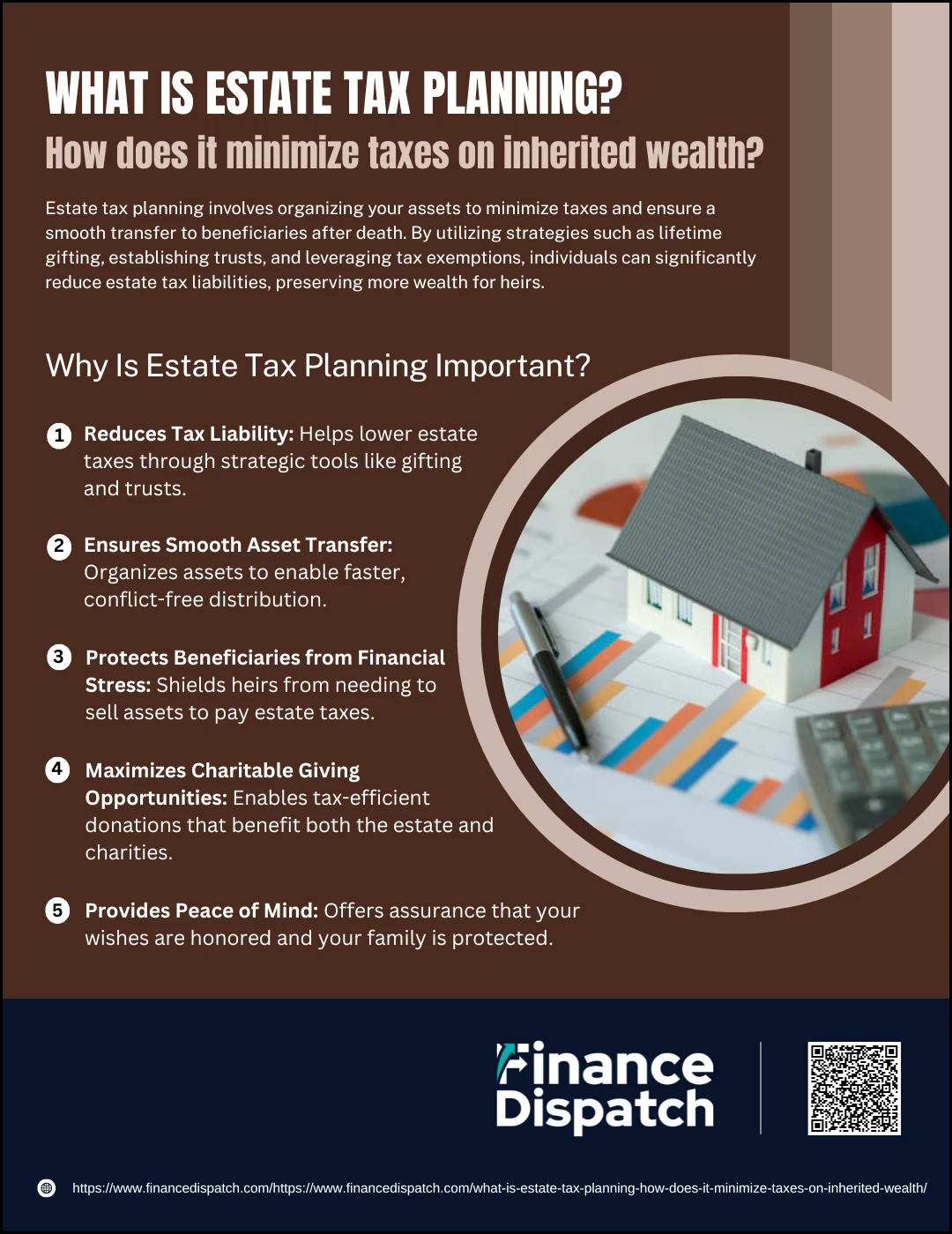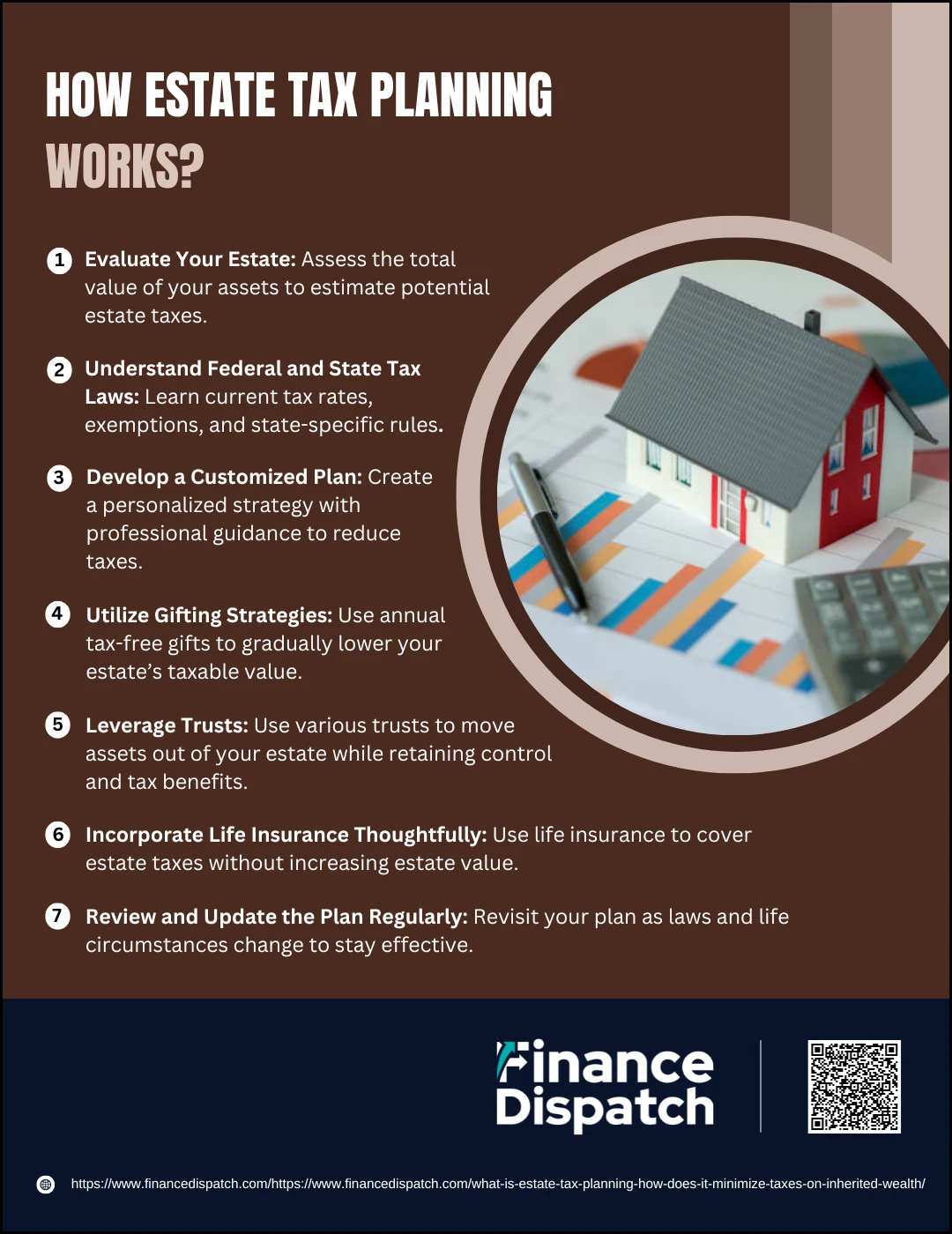Estate tax planning is a critical part of securing your financial legacy and ensuring your loved ones inherit the wealth you’ve built with minimal tax burdens. Without a strategic plan in place, a significant portion of your estate could be lost to federal or state taxes, leaving your heirs with less than you intended. By understanding the rules and utilizing smart planning tools, you can reduce or even eliminate these taxes. This article explores the essentials of estate tax planning and how it can help preserve your assets for future generations.
What Is Estate Tax Planning?
Estate tax planning is the process of organizing and managing your assets to minimize the taxes that may be owed upon your death. It involves strategic decisions about how your wealth will be transferred to your heirs, with the goal of reducing the estate’s taxable value. This includes utilizing tools such as trusts, lifetime gifting, life insurance policies, and charitable donations. By taking a proactive approach, estate tax planning ensures that a greater portion of your wealth reaches your beneficiaries, rather than being diminished by federal or state taxes.
 Why Is Estate Tax Planning Important?
Why Is Estate Tax Planning Important?
Estate tax planning plays a critical role in safeguarding your legacy. It allows you to anticipate potential tax burdens and take steps to minimize them before they affect your heirs. Without careful planning, a large portion of your estate could be consumed by federal or state estate taxes, leaving less for your loved ones. By developing a solid plan, you ensure that your wealth is distributed according to your wishes and in the most tax-efficient manner.
1. Reduces Tax Liability
One of the main goals of estate tax planning is to lower the amount of taxes that must be paid when transferring assets. Federal estate taxes can reach up to 40%, and some states impose their own taxes as well. Strategies like gifting, creating trusts, and utilizing exemptions can help decrease your taxable estate, ensuring more of your wealth is preserved for your heirs.
2. Ensures Smooth Asset Transfer
Estate tax planning includes organizing your financial affairs so that your assets are passed on quickly and with minimal legal complications. Tools like revocable trusts or joint ownership can bypass the lengthy probate process. This smooth transition can reduce conflicts among beneficiaries and speed up access to funds during a potentially stressful time.
3. Protects Beneficiaries from Financial Stress
Without proper planning, your heirs might face a large tax bill upon receiving their inheritance. This could force them to sell valuable assets such as property or investments just to cover the tax liability. Estate tax planning helps ensure they receive their inheritance intact, without the pressure of liquidating family assets.
4. Maximizes Charitable Giving Opportunities
If charitable giving is part of your legacy, estate planning allows you to structure donations in a tax-efficient way. Vehicles like charitable remainder trusts or donor-advised funds can provide income to you during your lifetime while reducing your estate’s taxable value and benefiting the charity of your choice after your passing.
5. Provides Peace of Mind
Perhaps most importantly, estate tax planning offers peace of mind. Knowing that you have taken the steps to protect your family’s financial future and reduce their burden can bring comfort. It also ensures that your wishes are clearly documented and legally enforceable, minimizing the chance of disputes or confusion later on.
Key Elements of Estate Tax Planning
Understanding the core components of estate tax planning is essential to crafting a strategy that protects your assets and ensures your loved ones receive the maximum benefit. Each element plays a distinct role in reducing your estate’s taxable value and simplifying the transfer process for your heirs. A well-rounded estate plan takes all of these components into account, adapting them to your specific financial situation and goals.
1. Federal Estate Tax: The federal estate tax applies to estates that exceed the exemption threshold ($13.99 million per individual in 2025). Knowing how to structure your estate to remain below this limit—or to use available deductions—is crucial to avoiding unnecessary tax burdens.
2. State Estate and Inheritance Taxes: Some states impose additional estate or inheritance taxes, often with lower exemption thresholds than the federal level. Understanding your state’s laws helps in determining whether relocation or strategic gifting could be beneficial.
3. Gift Tax Exclusions and Exemptions: Annual gift tax exclusions (up to $19,000 per recipient in 2025) and the lifetime gift tax exemption allow you to reduce your taxable estate by giving assets away during your lifetime without triggering taxes.
4. Trusts: Trusts are powerful tools in estate tax planning. Irrevocable trusts, for example, remove assets from your taxable estate, while charitable trusts can provide tax benefits and philanthropic impact. Properly structured trusts also help manage and control asset distribution.
5. Life Insurance: Life insurance can provide liquidity to pay estate taxes, preventing the need to sell other assets. Using an Irrevocable Life Insurance Trust (ILIT) can keep the death benefit outside of your taxable estate.
6. Asset Valuation: Accurately valuing your estate—including real estate, investments, and personal property—is the foundation of any estate tax plan. It allows you to assess potential tax liabilities and determine which strategies are most appropriate.
7. Beneficiary Designations: Keeping beneficiary designations up to date on retirement accounts, insurance policies, and other assets ensures they pass directly to your heirs, often avoiding probate and reducing taxable estate value.
8. Professional Guidance: Estate planning involves complex legal and financial considerations. Working with estate planning attorneys, tax professionals, and financial advisors ensures that your plan is legally sound and tax-efficient.
 How Estate Tax Planning Works
How Estate Tax Planning Works
Estate tax planning is a proactive process that involves evaluating your financial situation, understanding current tax laws, and applying specific strategies to minimize the tax burden on your estate. The goal is to preserve as much of your wealth as possible for your beneficiaries while ensuring a smooth and efficient transfer of assets. By following a structured approach, you can significantly reduce or even eliminate estate taxes.
1. Evaluate Your Estate
Begin by determining the total value of your estate. This includes real estate, investments, retirement accounts, life insurance policies, business interests, and personal property. Accurate valuation is essential for estimating potential estate tax liabilities and choosing the right planning tools.
2. Understand Federal and State Tax Laws
Familiarize yourself with current estate tax thresholds, rates, and exemptions. For 2025, the federal estate tax exemption is $13.99 million per individual. Also, research whether your state imposes its own estate or inheritance tax, as laws and exemption limits vary by state.
3. Develop a Customized Plan
Work with a qualified estate planning professional to create a tailored strategy. This may include establishing trusts, utilizing annual gift tax exclusions, purchasing life insurance, or making charitable contributions—all designed to reduce your estate’s taxable value.
4. Utilize Gifting Strategies
Make tax-free gifts during your lifetime to lower your taxable estate. The IRS allows you to gift up to $19,000 per person per year (as of 2025) without triggering gift taxes. Over time, this can substantially reduce the size of your estate.
5. Leverage Trusts
Trusts such as irrevocable trusts, charitable remainder trusts (CRTs), and generation-skipping trusts (GSTs) can remove assets from your taxable estate while providing control over distribution and potential tax advantages.
6. Incorporate Life Insurance Thoughtfully
Life insurance can provide the liquidity needed to pay estate taxes, avoiding the forced sale of valuable assets. Placing the policy in an Irrevocable Life Insurance Trust (ILIT) keeps the proceeds outside your taxable estate.
7. Review and Update the Plan Regularly
Tax laws and personal circumstances change over time. It’s essential to revisit your estate tax plan periodically—especially after major life events like marriage, divorce, the birth of a child, or significant financial changes—to keep it aligned with your goals.
 Strategies to Minimize Taxes on Inherited Wealth
Strategies to Minimize Taxes on Inherited Wealth
Minimizing taxes on inherited wealth requires a thoughtful combination of legal tools and financial strategies. By planning ahead, you can significantly reduce the estate tax burden on your heirs and ensure more of your assets are preserved for future generations. Below are proven strategies you can implement to make your estate more tax-efficient.
1. Lifetime Gifting
Giving away assets while you’re still alive can effectively lower your taxable estate. The IRS allows an annual gift tax exclusion of $19,000 per recipient in 2025. You can also use your lifetime gift tax exemption to transfer significant wealth without incurring taxes, gradually reducing your estate’s value over time.
2. Establishing Irrevocable Trusts
Assets placed in irrevocable trusts are removed from your estate and no longer count toward your taxable value. These trusts can be tailored to benefit family members, fund charities, or hold life insurance policies, all while offering protection from estate taxes and probate.
3. Using a Qualified Personal Residence Trust (QPRT)
A QPRT allows you to transfer ownership of your home to a trust while retaining the right to live there for a specific number of years. This strategy lowers the home’s taxable value and removes it from your estate after the trust term ends, benefiting your heirs.
4. Creating a Family Limited Partnership (FLP)
An FLP lets you transfer business or investment interests to family members at a discounted value while maintaining control of the assets. This structure reduces your estate’s value and offers a tax-efficient way to pass wealth to your children or grandchildren.
5. Leveraging Life Insurance
Life insurance can provide cash to pay estate taxes, ensuring other assets don’t need to be sold. Holding the policy in an Irrevocable Life Insurance Trust (ILIT) excludes the proceeds from your taxable estate, preserving the full benefit for your heirs.
6. Donating to Charity
Charitable giving reduces the size of your estate while supporting causes you care about. Options like Charitable Remainder Trusts (CRTs) or Charitable Lead Trusts (CLTs) provide tax deductions and help you fulfill philanthropic goals while reducing estate taxes.
7.Generation-Skipping Transfer (GST) Planning
By transferring assets directly to grandchildren or beneficiaries two generations below you, you can avoid one layer of estate taxation. The GST exemption allows for significant tax savings when structured properly through a generation-skipping trust.
 Step-by-Step Guide to Estate Tax Planning
Step-by-Step Guide to Estate Tax Planning
Creating an effective estate tax plan requires a systematic approach tailored to your financial situation and long-term goals. This process helps you identify potential tax liabilities, implement strategies to reduce them, and ensure that your assets are passed on according to your wishes. Here’s a step-by-step guide to help you navigate estate tax planning with clarity and confidence.
1. Evaluate the Total Value of Your Estate
Begin by listing all your assets, including real estate, investments, retirement accounts, life insurance, business interests, and personal belongings. This will give you a clear picture of your estate’s overall value and help determine if it may exceed federal or state estate tax exemption thresholds.
2. Understand the Applicable Tax Laws
Familiarize yourself with federal estate tax laws—such as the $13.99 million exemption limit for 2025—and state-level estate or inheritance tax rules, which vary widely. Knowing these regulations is essential for effective tax planning.
3. Define Your Estate Planning Goals
Identify what you want to achieve with your estate plan—minimizing taxes, preserving wealth, supporting charities, or ensuring financial security for your heirs. Your goals will shape the strategies and tools you use.
4. Consult Estate Planning Professionals
Engage with experienced professionals such as estate planning attorneys, tax advisors, and financial planners. They can help you understand complex laws, develop tax-saving strategies, and ensure that all legal requirements are met.
5. Select and Implement Estate Planning Tools
Based on professional advice and your goals, choose appropriate tools such as wills, trusts, lifetime gifts, charitable donations, and life insurance policies. Ensure these tools are customized to fit your needs and reduce your taxable estate.
6. Review Beneficiary Designations
Make sure all retirement accounts, insurance policies, and payable-on-death accounts have updated and appropriate beneficiaries. This ensures assets transfer directly and may avoid probate, helping to reduce tax implications.
7. Ensure Proper Documentation
Draft and securely store all necessary documents, including your will, trust agreements, durable powers of attorney, and healthcare directives. Keep them accessible and up-to-date to avoid legal complications later.
8. Reassess and Update Your Plan Regularly
Life events such as marriage, divorce, the birth of a child, or a significant financial change should trigger a review of your estate plan. Additionally, keep an eye on changes in tax laws that may affect your strategy.
Tools and Strategies to Reduce Estate Taxes
Reducing estate taxes requires a combination of legal instruments and strategic planning techniques. These tools not only help minimize the taxable value of your estate but also ensure a smoother transfer of wealth to your beneficiaries. Selecting the right mix depends on your financial situation, family dynamics, and long-term goals. The table below outlines some of the most effective tools and strategies used in estate tax planning, along with their functions and benefits.
| Tool/Strategy | Purpose | Key Benefits |
| Irrevocable Trusts | Transfer assets out of taxable estate | Removes asset value from estate, offers control over distribution |
| Annual Gifting | Reduce estate size through tax-free gifts | Up to $19,000 per recipient (2025), no gift tax incurred |
| Lifetime Gift Tax Exemption | Transfer large assets without immediate tax | Uses part of the $13.99M exemption, decreases estate value |
| Charitable Remainder Trust (CRT) | Donate assets while receiving income | Reduces estate, provides lifetime income, offers tax deductions |
| Charitable Lead Trust (CLT) | Donate income from assets for a set period | Reduces estate value and benefits charities before heirs |
| Qualified Personal Residence Trust | Transfer residence at a discounted value | Keeps use of home for a term, lowers taxable value of gift |
| Family Limited Partnership (FLP) | Pass on business/assets at reduced tax value | Discounts asset value, retains control while reducing estate |
| Irrevocable Life Insurance Trust (ILIT) | Keep life insurance proceeds out of estate | Provides liquidity for taxes, avoids inclusion in taxable estate |
| Generation-Skipping Trust | Transfer wealth to grandchildren, bypassing one generation | Minimizes double taxation, utilizes GST tax exemption |
| Spousal Portability | Combine unused estate tax exemptions between spouses | Doubles exemption for married couples |
Common Mistakes to Avoid in Estate Tax Planning
Even with the best intentions, estate tax planning can go wrong if certain critical errors are overlooked. These mistakes can lead to higher tax liabilities, delays in asset distribution, or unintended consequences for your beneficiaries. By recognizing and avoiding these pitfalls, you can protect your legacy and ensure that your estate plan functions as intended.
1. Failing to create or Update Your Estate Plan: Not having an estate plan—or letting it become outdated—can lead to confusion, missed tax-saving opportunities, and unintended distributions of assets.
2. Overlooking State Estate and Inheritance Taxes: Many people plan only for federal taxes, forgetting that some states impose additional estate or inheritance taxes with lower exemption thresholds.
3. Improper Use of Beneficiary Designations: Leaving beneficiary designations blank or inconsistent with your will can result in assets being taxed or distributed contrary to your wishes.
4. Naming the Estate as Life Insurance Beneficiary: Doing this brings the proceeds into your taxable estate, potentially increasing the estate tax liability unnecessarily.
5. Missing Out on Gift Tax Exclusions: Not using the annual gift tax exclusion or the lifetime gift tax exemption means missing a simple and legal way to reduce your taxable estate.
6. Lack of Liquidity to Pay Estate Taxes: If your estate lacks cash, heirs may be forced to sell valuable assets quickly to pay taxes—often at an unfavorable price.
7. Neglecting to Plan for Business Succession: Business owners who fail to plan for succession risk tax complications and operational disruptions that can devalue the estate.
8. Not Consulting Professionals: Trying to handle complex estate tax planning without legal or financial expertise can result in costly errors and missed opportunities for tax savings.
The Role of Estate Planning Professionals
Estate planning professionals play a crucial role in developing and executing a tax-efficient estate plan tailored to your specific financial goals and family needs. Attorneys specializing in estate law ensure that your documents—such as wills, trusts, and powers of attorney—are legally sound and compliant with current tax regulations. Financial advisors help structure your assets to align with long-term planning objectives, while tax professionals or CPAs identify opportunities to minimize estate and gift taxes. These experts work together to create a cohesive strategy that protects your wealth, simplifies asset transfers, and ensures your wishes are honored. Collaborating with qualified professionals provides peace of mind and helps you avoid costly mistakes that could undermine your estate’s value.
Conclusion
Estate tax planning is a vital component of protecting your financial legacy and ensuring your loved ones receive the wealth you intend to pass on. By understanding tax laws, utilizing smart strategies like gifting, trusts, and life insurance, and working with qualified professionals, you can significantly reduce or even eliminate estate tax burdens. A well-structured plan not only preserves more of your assets but also ensures a smoother and more meaningful transition of wealth across generations. Taking action now will provide long-term peace of mind and financial security for you and your beneficiaries.



